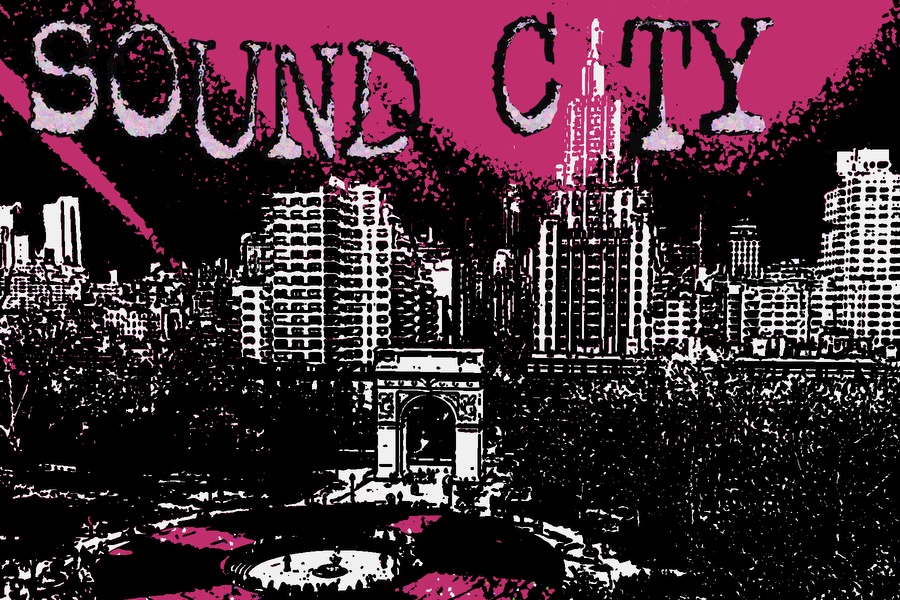On Scott Ave.
SoundCity is a column uncovering New York City’s hidden sounds—the musical experiences that often go unnoticed yet define the city’s character—tracking the people and places shaping NYC’s sonic and physical landscape.
I dedicated the night of March 27th to 154 Scott Avenue, home to SAA, a club devoted to culture, community, and enrichment in Bushwick. Within the club, there are multiple spaces equipped for DJ sets, parties, and listening events.
There were two events happening in two different spaces of SAA that night.
- The first was at 7:30pm at Car Park, a cavernous garage-like venue. The performance was titled “SOURCE1.” On DICE, it was described as the “debut sound+movement piece from the duo Premortal. Body and mechanized systems conversing to the reverb of an empty garage. Flesh, metal, water and sonic confusion harmonizing, creating a prelude of mortality.” I could find absolutely nothing else about it online.
- The second event was at 10:00pm at Sangs, an underground discotheque space inside the social club of SAA. The event featured DJ sets by siblings Blu DeTiger and Rex DeTiger.
Though both experiences took place a few hundred feet away from each other, they belonged to entirely different worlds.
“Is this the SOURCE1 Car Park line?” I asked a woman who seemed like she would know.
She nodded. “Did you walk over the little bridge?” she asked my friend Alexis and me.
We did not. We took an Uber to the door. We did not traipse over or even know of any little bridges—just one of Bushwick’s many industrial mysteries we had yet to unravel.
Scott Avenue is a non-place. This is a term coined by French anthropologist Marc Augé to describe transient spaces of modernity where people remain anonymous—think highways, supermarkets, the backrooms, etc. These are spaces that lack the relational, historical, or identity-forming qualities that define what we traditionally think of as “places.”
Where are we?
Concrete, fence, shipping containers, sidewalk, nondescript door. The lack of identity-forming qualities added to the seduction of the event we were anxiously anticipating. But when the queue eventually doubled in size, Scott Avenue became a place; the people waiting were the identity-forming qualities. And visual anonymity didn’t seem to be the goal.
Alexis stepped out of the queue to smoke a cigarette in an effort to combat the evening’s wet cold. He scanned the crowd and then made eye contact with me, giving me a sharp nod, gesturing up at something to my left. It was the little bridge!
We finally were allowed entry into the garage after waiting for 30 minutes. It was chilly inside—a glowing red light illuminating the passage to the main room and a deep industrial buzzing thickened the vast space with a semi-demonic spirit. People were smiling, hushed, and giddy—but deeply unsure as per everyone’s slow gait. The “you go first” energy was palpable even through the clouds of artificial fog.
Alexis and I settled onto a black couch and Sarah, the woman who asked about the little bridge, seated herself on the couch across from us.
“Have you been to something like this before?” I asked her.
“Well yeah, but not this particular performance. I’m friends with the dancer.” She lifted her leg and laid it horizontally on the black leather, stretching over it. Her fingertips extended up as if she was trying to reach the ceiling.
“I assume you’re also a dancer?” I asked. She nodded.
This cocktail hour of sorts lasted about 30 minutes. The DJ duo Premortal set an eerie mood with their eclectic mixes—think EDM Björk with sprinkles of crashing metal and R&B.
The extraterrestrial house beats started to simmer down, and the audience gathered around the center of the garage where a whitish tarp was semi-taught suspended in the air by two construction grade scissor lifts.
The dancer walked into the center. She wore nothing but a very small pair of underwear and was covered in a sticky-glue-like coating, along with a muddy substance. The lifts rose and fell, singing a steady beep as the dancer contorted her body inwards, outwards, up, and down. She repeatedly slammed herself onto the cold concrete floor. At one point, she ripped off some of the glueish skin.
Other than the duo playing a few vague metallic sounds that accompanied the performance and the beeping, the space was dead silent. The crowd—standing still, staring. A man who was part of the behind-the-scenes of the performance poured water on her while she laid on her back, the tarp covering her. The concrete was coarse. The garage was freezing. She had such an aggressive affinity to the concrete ground that it was hard to watch.
The DICE description of the performance as being a “prelude of mortality,” but the thematic implications were opaque to me. Was this meant to depict hell? Life? A testing of the body’s limits, perhaps? Most of the SOURCE1 audience did not know what they were looking at, so we looked harder. The abstraction of it all forced us to focus on the physicality of what was actually happening in front of us. The impressive extensions of her legs, the way she leapt and did somersaults on the concrete, the water being mercilessly dumped on her.
We were so in tune with her physicality we became, subconsciously, more in tune with our own physicality as an audience. Keeping our breathing to a quiet minimum, craning our heads so as to not get in the way of anyone’s view, keeping our arms by our sides.
Audience and performance are inextricably linked—this connection can have an intoxicating, almost hypnotic effect. There were two “preludes of mortality” unfolding at once—one within the performance art itself, and another in the realization that our collective focus and behavior were, in their own way, shaping the performance’s meaning. A deep awareness of the body—hers and ours.
The performance was over; we all clapped loudly and the SOURCE1 team hugged. Everyone’s bodies floated back down to earth.
PART II
At 10:00 on the dot we were back. Call us regulars. Sangs, the next venue, was essentially the basement of SAA. We sat in the bar area before the sets. At 10:03 we excitedly headed downstairs, stopped, pivoted, and beelined back up when we realized Blu DeTiger was the only one down there.
We usually wouldn’t be this timid, but truthfully, we were both a bit starstruck. I’ve been following Blu DeTiger’s bass career since the COVID-19 lockdowns, watching videos of her slapping away to Prince with a calm dexterity.
Blu has played bass for FLETCHER and Caroline Polacheck, opened for acts like Sabrina Carpenter, ODESZA, and Bleachers, and headlined her own European tour in 2022. She’s hit major festivals like Bonnaroo, Governors Ball, and Electric Forest, and landed on Forbes 30 Under 30 in 2023. After a stint at NYU’s Clive Davis Institute, she left to focus on music full-time. Her debut album All I Ever Want Is Everything dropped in March 2024—and next, she’s hitting the Coachella DoLab April 11th-13th. All this to say, her talent is recognized and celebrated worldwide. And Blu is not the only musical one in the family. Her brother Rex, a drummer and producer, is featured on All I Ever Want Is Everything and also opened for ODESZA alongside Blu.
Back in our stools upstairs, we heard reverberations of Blu using the mic to practice for her imaginary crowd.
“Everyone put your fucking hands up!” she giggled into the mic.
People quickly started to trickle in, and we went downstairs for real this time. The space was cool, shiny, velvety and red. A disco ball hung prominently in the center. Rex kicked off the night with his set. Most people were seated in the back on the black lounge furniture at first. The energy Rex fed us was building, but not quite intense yet.
I read Josh Kitchen’s interview with Rex from Setlist Kitchen where he talked about his role as a DJ. He said, “When I DJ, no one’s there for me specifically. I’ll post about it on my story or whatever, but it’s just a club where people come every weekend. So I’m really there for them, like a comedian: if they’re not into it, I’m doing it wrong. I can’t go in with a huge ego—I need to satisfy the crowd, the club owners, and everyone else.”
We began to dance and Rex matched the crowd’s growing energy—or perhaps we unknowingly matched his. Blu eventually joined him behind the booth for a sort of trade off. Her signature blue Fender Jazz Bass sparkled attractively on its stand. The dance floor was full now and the crowd slowly inched towards the booth, eager for what they knew was to come.
Blu answered the call and slipped on her bass, immediately gripping the crowd’s undivided, drunken attention. She swung her head from side to side as her fingers easily slid down the neck of her signature bass. Almost as if her fingers were pressing down on tightly coiled springs, sharply ricocheting once released. With this, she managed to make “three, six, nine, girls wanna drink wine” funky. Blu’s slap rang in my ears long after I got home.
New Zealand-born socio-musicologist Christopher Small has a word engaging with music that he calls, “musicking.” In his book, Musicking, he explains, “The act of musicking establishes in the place where it is happening a set of relationships, and it is in those relationships that the meaning of the act lies. They are to be found not only between those organized sounds which are conventionally thought of as being the stuff of musical meaning but also between the people who are taking part, in whatever capacity, in the performance; and they model, or stand as metaphor for, ideal relationships as the participants in the performance imagine them to be: relationships between person and person, between individual and society, between humanity and the natural world and even perhaps the supernatural world.”
In other words, the way we behave during such performances reveals a greater truth about how people wish the world to be—how they imagine or hope to relate to others, to community, to the environment, and even to spiritual forces. Musical performance becomes a ritual of ideal connection.
At the SOURCE1 performance, the ideal connection we materialized was a shared sense of respect, quiet, and awareness for the dancer; at Sangs, it was a communal yearn for a joyful escape. To feel internally pretentious or good about ourselves without having to act pretentious. By the end of the night we both felt like a part of these rituals, as well as a deeper connection to Bushwick—in all its extrinsic secrecy.
I’ll definitely be returning to Scott Avenue…and next time, by bridge.

